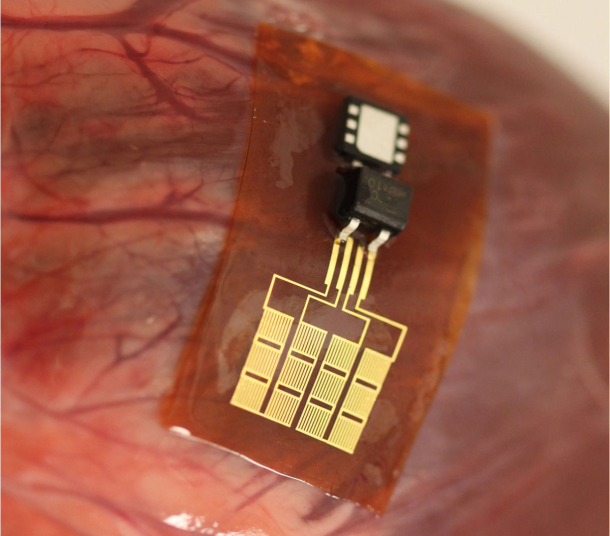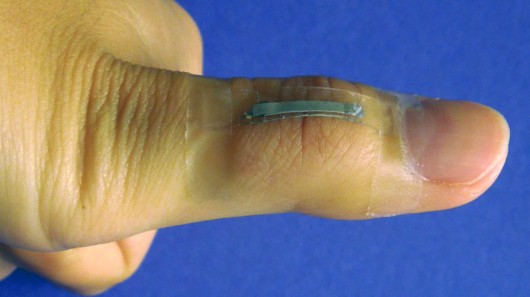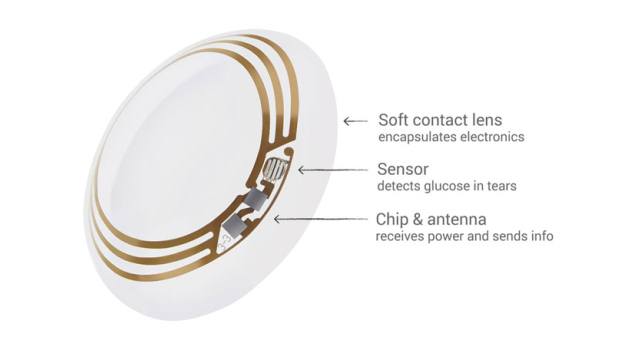Category: Sensors
-

Piezoelectric nanoribbons power pacemakers
http://news.cnet.com/8301-11386_3-57617483-76/nanoribbons-let-beating-hearts-power-their-own-pacemakers/ Scientists are studying various steady energy source alternatives for small biomedical sensors, including piezoelectric power. University of Illinois researchers have attached small, flexible strips (piezoelectric nanoribbons) to internal organs of animals, and harvested energy from their movement to power pacemakers and other medical devices. Current practice depends on hard-to-change batteries. This is a minimally invasive power source,…
-
Sensors detect radiation complications early, at home
http://www.ncbi.nlm.nih.gov/pubmed/24395986 Susan Peterson and colleagues at MD Anderson have completed a feasibility study showing that equipping head and neck cancer patients with home-based sensors can identify dehydration during radiation treatment. Physicians reviewed patients’ information daily using CYCORE (CYberinfrastructure for COmparative Effectiveness REsearch), a software-based platform to collect and manage data from multiple systems through a suite of home-based and…
-

Wearable, multifunctional, silver nanowire sensor for prosthetics, robotics
http://pubs.rsc.org/en/Content/ArticleLanding/2014/NR/C3NR05496A#!divAbstract North Carolina State University researchers have developed a thumb joint mounted, multifunctional sensor using silver nanowires that measures strain, pressure, human touch and bioelectronic signals. With potential biomedical, military and athletic applications, the sensor can be used for prosthetics, robotic systems and flexible touch panels. “The technology is based on either physical deformation or…
-

Smart contact lens prototype to monitor glucose
http://googleblog.blogspot.com/2014/01/introducing-our-smart-contact-lens.html Google is testing a smart contact lens that’s built to measure glucose levels in tears. It uses a tiny wireless chip and miniaturized glucose sensor embedded between two layers of soft contact lens material. The prototype can generate a reading once per second. They are investigating the potential of integrating tiny LED lights that…
-
Smart contact lens with potential to monitor intraocular pressure
http://www.nature.com/ncomms/2014/140107/ncomms3982/full/ncomms3982.html Swiss Federal Institute of Technology scientists have developed a light, flexible, ultra-thin membrane with the potential to detect intraocular pressure in glaucoma. Researchers claim that the technology “could offer significant advantages over existing solutions in terms of thickness, lightness, and transparency and, hence, comfort for the patient.” The device consists of layered polymer films, one…
-
Nerve stimulation for sleep apnea
http://www.nejm.org/doi/full/10.1056/NEJMoa1308659 Current sleep apnea treatments are intrusive and uncomfortable. University of Pittsburgh Professor Patrick J. Strollo has developed a “pulse generator” which, when surgically implanted, senses one’s effort to breath. It then sends pulse stimulation to the hypoglossal nerve, controlling the neck muscles that keep the airway open, preventing collapse. Standard treatment for sleep apnea is…
-
Baby onesie tracks breathing, sleep, movement, temperature
http://mimobaby.com/ Sensor based baby monitoring is receiving a lot of exposure at CES. One such monitor, by Mimo baby, includes three parts: the Kimono, the Turtle and the Lilypad station. The Kimono is a cotton onesie, with machine washable sensors, worn by a baby when sleeping. It houses the Turtle, which tracks a baby’s respiration,…
-
“Vapor nanobubble” laser scanner detects malaria through skin
http://www.pnas.org/content/early/2013/12/26/1316253111.abstract Rice University researchers have developed noninvasive technology that accurately detects malaria through the skin in seconds with a laser scanner. The “vapor nanobubble” requires no dyes or diagnostic chemicals, and there is no need to draw blood. In a recent study, the technology detected even a single malaria-infected cell among a million normal cells with…
-
Microscale torsional muscle system can simulate active neuromuscular system
http://newscenter.lbl.gov/news-releases/2013/12/19/a-micro-muscular-break-through/ U.S. Department of Energy and Lawrence Berkeley National Laboratory researchers have developed a micro-sized robotic torsional muscle/motor made from vanadium dioxide. For its size, it is a thousand times more powerful than a human muscle, able to catapult objects 50 times heavier than itself over a distance five times its length within 60 milliseconds. “Multiple…
-
Nerve impulse sensor exoskeleton assists paraplegics, Parkinson’s, stroke patients
http://www.dw.de/standing-again-with-nerve-controlled-robotics/a-17280419 Professor Thomas Schildhauer leads a team at Bergmannsheil University Clinic’s “Center for Neuro-Robotic Mobility Training” that uses nerve impulse sensors to help patients walk again. A robotic exoskeleton with sensors affixed to the hips and legs gives paraplegics, Parkinson’s and stroke patients a sense of stability during ambulatory exercises. The robot suit contains numerous sensors that…
-
Molecular sensor for early detection of Multiple Sclerosis
http://onlinelibrary.wiley.com/doi/10.1002/ana.24078/abstract UCSF’s Gladstone Institute researchers have created a molecular sensor that can detect MS at its earliest stages — before the onset of physical signs. Professor Katerina Akassoglou’s study revealed in animal models that the heightened activity of a protein called thrombin in the brain could serve as an early indicator of MS. By developing a fluorescently…
-
Capsule endoscopy modification detects stomach cancer via “diagnostic pill”
http://www.inderscience.com/info/inarticle.php?artid=57925 Researchers at Chongqing University in China have developed an ingestible capsule capable of detecting chemical precursors of a gastric tumor. The findings might allow oncologists to catch the disease at a very early stage. It is based on a modification of existing capsule endoscopy to detect occult bleeding — tiny quantities of blood associated with…